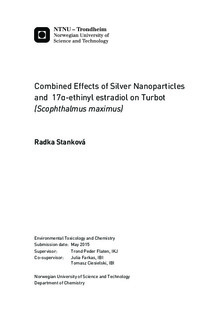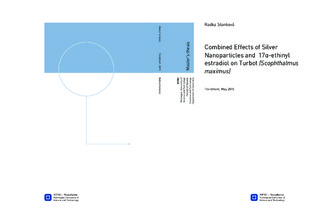| dc.description.abstract | Due to their antimicrobial properties silver nanoparticles are one of the most used nanomaterials in the commercially available products nowadays. The exponential increase in production of nanomaterials raises concerns about the environmental hazards to aquatic organisms. Previous exotoxicological studies have shown that silver nanoparticles can be toxic to fish. However, combined effects of silver nanoparticles with other pollutants have not been studied in depth so far.
In this study, the uptake and effects of low and high concentrations of silver nanoparticles (AgNPs) and 17α-ethinyl estradiol (EE2), both alone and in combination on juvenile turbots (Scophthalmus maximus), were investigated. A solution of silver nitrate (AgNO₃) containing 50 μg/L Ag ions was included in order to differentiate the effects of AgNP from that of ionic silver. The AgNP agglomerate dissolution was determined by ultracentrifugation followed by ICP-MS analysis of the supernatant and independently by ion selective electrode. The amount of ionic silver within undiluted particle dispersions was determined to be 15 -25 %. The body distribution of Ag was measured by ICP-MS. Results show that after 13 days of pulsed exposure to AgNPs and AgNO₃ silver was detected in all organs that were evaluated (gills, stomach, liver, kidney, muscle) except for brain. The uptake of Ag into the tissues was dose dependent. In all analyzed tissues except for gills there was no statistically significant difference between high Ag exposure groups (AgNP200, AgNP200EE2 and Ag+). High concentration of Ag in the gills suggests that the AgNPs were trapped in the mucus layer or adsorbed on the gill surface. Detectable concentrations of Ag in organs and tissues indicate that Ag was probably taken up via the gastrointestinal route, crossed the epithelial barrier, accumulated in the liver and was excreted via the bile.
The ability of 17α-ethinyl estradiol to induce vitellogenin (Vtg) in plasma was measured with enzyme-linked-immunosorbent assay. The average measured vitellogenin concentrations in the control fish were 24 000 ng/mL. Fish exposed to EE2 treatment (EE2, AgNP2EE2, AgNP200EE2) showed significant induction of Vtg compared with the control group. The Vtg concentrations were 105 000 ng/mL, 98 000 ng/mL and 73 000 ng/mL, respectively. However, there was no statistically significant difference among these groups. The findings of this study showed that AgNPs probably do not enhance the effects of 17α-ethinyl estradiol in Scophthalmus maximus. | |

